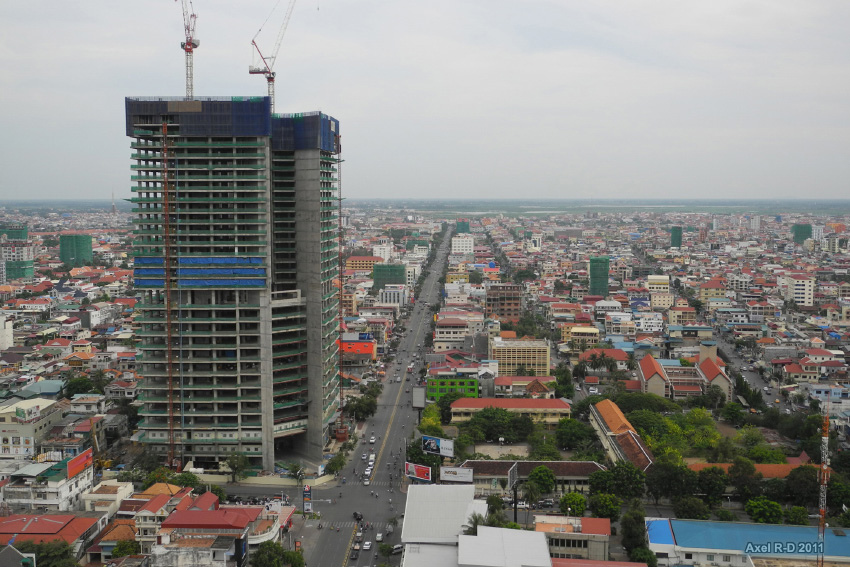
គម្រោងសាងសង់អាគារភ្នំពេញ ថាវវើ ថតដោយ Axel Drainville, នៅថ្ងៃទី ០៤ ឧសភា ២០១១។ ក្រោម អាជ្ញាប័ណ្ណ៖ CC BY-NC 2.0
វិស័យឧស្សាហកម្មសំណង់នៅក្នុងប្រទេសកម្ពុជាកំពុងមានការរីកចម្រើនយ៉ាងខ្លាំង។ យោងតាមទិន្នន័យក្រសួងរៀបចំដែនដី នគរូបនីយកម្ម និងសំណង់ វិនិយោគទុនក្នុងឆ្នាំ២០១៥ មានតម្លៃប្រមាណ ៣.៥ពាន់លានដុល្លារ ជាកំណើន៤០ភាគរយពីតួរលេខ ២.៥ពាន់លានដុល្លារក្នុងឆ្នាំ២០១៤ ។1
ជាមួយគ្នានឹងវិស័យវាយនភ័ណ្ឌ ទេសចរណ៍ និងកសិកម្ម វិស័យសំណង់ ជាវិស័យមួយក្នុងចំណោមវិស័យចម្បងទាំង៤ ដែលជម្រុញការរីកលូតលាស់នៃសេដ្ឋកិច្ចរបស់ប្រទេសកម្ពុជា។2ការប៉ានស្មានរបស់ធនាគារពិភពលោក បានបង្ហាញថា វិស័យសំណង់ និងអចលនទ្រព្យតំណាងឱ្យ ២ភាគរយនៃតួរលេខ៧.១ នៃកំណើនក្នុងស្រុកសរុប ក្នុងឆ្នាំ២០១៤ ដែលនាំឱ្យវិស័យនេះជាវិស័យតែមួយគត់ដែលរួមចំណែកធំជាងគេក្នុងការលូតលាស់នៃសេដ្ឋកិច្ចជាតិក្នុងឆ្នាំនោះ។3
ការរីកចម្រើននៃវិស័យសំណង់នៅកម្ពុជា បានផ្លាស់ប្តូរមុខមាត់នៃទីក្រុងជាច្រើន។ អ្នកគ្រប់គ្រងជាន់ខ្ពស់នៃក្រុមហ៊ុនអចលនទ្រព្យមួយរូបបាននិយាយថា ក្នុងឆ្នាំ២០០៩ ស្ទើរតែមិនមានសំណង់អាគារខុនដូរនោះទេក្នុងរាជធានីភ្នំពេញ ប៉ុន្តែក្នុងឆ្នាំ២០១៧វិញ មានការំពឹងទុកថាសំណង់ប្រភេទនេះនឹងមានដល់ទៅ ៥,០០០ អាគារ។4
កំណើននៃការសាងសង់នេះនៅតែបន្តកើនឡើង បើទោះបីជាសំណើរសើ្នរសុំការសាងសង់ត្រូវចំណាយអស់ថវិការជាច្រើន និងមានរយៈពេលយូរជាងប្រទេសដ៏ទៃទៀតក៏ដោយ។ មតិព្រួយបារម្ភជុំវិញស្តង់ដារនៃការសាងសង់ និងសុវត្ថិភាពនៅការដ្ឋានត្រូវបានលើកឡើង។5បញ្ហាទាំងនេះនឹងអាចត្រូវបានយកទៅពិភាក្សាខ្លះៗក្នុងការធ្វើសេចក្តីព្រាងច្បាប់នៃការសាងសង់ថ្មី ដែលកំពុងតែដំណើរការនៅពេលថ្មីៗនេះ។
ក្របខណ្ឌគតិយុត្តិជុំវិញបញ្ហាដីធ្លី និងការសាងសង់
ភាពជាម្ចាស់កម្មសិទ្ធិលើដីធ្លី ត្រូវបានកំណត់ឱ្យពលរដ្ឋកម្ពុជាតែប៉ុណ្ណោះ។ ក្រុមហ៊ុន រឺនីតិបុគ្គលផ្សេងទៀត មានសិទ្ធិកាន់កាប់ដីធ្លីបាន ប្រសិនបើភាគហ៊ុន ៥១ភាគរយ រឺច្រើនជាងនេះក្នុងក្រុមហ៊ុន រឺអង្គភាពត្រូវបានគ្រប់គ្រងដោយពលរដ្ឋកម្ពុជា។ ទោះបីជាជនបរទេស មិនអាចមានកម្មសិទ្ធិភាពក៏ដោយ ពួកគេអាចមានសិទ្ធិជួលដីបានរហូតដល់រយៈពេល៧០ឆ្នាំ។
ចំពោះរាល់អាគារ ដែលបានបែងចែកកម្មសិទ្ធិតាមជាន់ ជនបរទេសអាចមានកម្មសិទ្ធិរហូតដល់ ៧០ភាគរយលើអាគារខនដូរចាប់ពីជាន់ទី០១ ឡើងទៅ។ ជនបរទេសមិនអាចមានកម្មសិទ្ធិលើអចលនទ្រព្យនៅជាន់ផ្ទាលដីបានទេ។
ច្បាប់ស្តីពីការសាង់សង់សំខាន់ៗបច្ចុប្បន្ននេះស្ថិតនៅក្រោមច្បាប់ស្តីពីការគ្រប់គ្រង និងរៀបចំសំណង់ (១៩៩៤)។ ច្បាប់នេះមានមាត្រាចំនួន៥០ ស្តីអំពីដំណើរការនៃការស្នើរសុំនិងទទួលបានសិទ្ធិក្នុងការសាងសង់។ មាត្រាទាំងនេះត្រូវបានអនុម័តដោយ អនុក្រឹត្យលេខ៨៦ទៅលើការអនុញ្ញាតិសាងសង់ (១៩៩៧) ដែលបានកំណត់អំពីសិទ្ធិសម្រាប់ប្រជាពលរដ្ឋ ក្នុងការសាងសង់លើដីធ្លីកម្មសិទ្ធិផ្ទាល់ខ្លួន ក៏ដូចជាដំណើរការនៃការអនុញ្ញាតិនេះ។ ដើម្បីជាជំនួយដល់ប្រជាពលរដ្ឋក្រីក្រ ឱ្យទទួលបានទីលំនៅក្នុងតម្លៃសមរម្យ ផ្ទះតូចៗដែលសង់ពីឈើមិនតម្រូវឱ្យមានលិខិតអនុញ្ញាតិសាងសង់នោះទេ។6
មានដំណាក់កាលច្រើនជាង២០ ដើម្បីទទួលបានលិខិតអនុញ្ញាតិសាងសង់។ ម្ចាស់សំណង់ ឬម្ចាស់ការដ្ឋានតម្រូវឱ្យស្នើរសុំព័ត៌មានពីនាយកដ្ឋានគ្រប់គ្រងដែនដី នគរូបនីយកម្ម និងសំណង់ និងតម្រូវឱ្យបំពេញទម្រង់ស្នើរសុំ។7សម្រាប់ប្រជាជនដែលរស់នៅទីរួមខេត្ត តម្រូវឱ្យទៅសាកសួរព័ត៌មាននៅនាយកដ្ឋានប្រចាំមូលដ្ឋាន។ ម្ចាស់សំណង់តម្រូវឱ្យមានឯកសារគ្រប់គ្រាន់ តួយ៉ាង ប្លង់ស្ថាបត្យកម្ម និងវិស្វកម្ម ប័ណ្ណកម្មសិទ្ធិដីធ្លី អត្តសញ្ញាណប័ណ្ណសញ្ជាតិខ្មែរជាដើម។ ក្រសួងគ្រប់គ្រងដែនដីមានតួនាទីក្នុងការត្រួតពិនិត្យលើគ្រប់គម្រោងសាងសង់ទាំងអស់។ ក្នុងឆ្នាំ២០១៤ មានគម្រោងសាងសង់ចំនួន ១៩៣ ត្រូវបានរកឃើញថា គ្មានលិខិតអនុញ្ញាតិត្រឹមត្រូវនោះទេ។8
នៅពេលដែលតម្រូវឱ្យមានប្លង់គោល ឬប្លង់ប្រើប្រាស់ដីនិងសំណង់ វាគួរតែមានការរឹតបន្តឹងទៅលើ ទំហំ ប្រភេទសំណង់ និងគោលបំណងនៃសំណើរសុំការសាងសង់។
សំណង់អាគារពាណិជ្ជកម្មនានា ដែលមានទំហំធំជាង ៣,០០០ម៉ែត្រការ៉េ ចាំបាច់ត្រូវមានលិខិតអនុញ្ញាតិពីក្រសួង។9ការសាងសង់ត្រូវចាប់់ផ្តើមក្នុងរយៈពេលមួយឆ្នាំ បន្ទាប់ពីពេលដែលការអនុញ្ញាតិត្រូវបានប្រកាស។ រាល់ការពន្យារពេលសាងសង់អាចធ្វើទៅបានលុះត្រាតែមានសំណុំឯកសារសុំពន្យារពេល។ វិញ្ញាប័នបត្រត្រូវផ្តល់ជូនបន្ទាប់ពីការងារសាងសង់ត្រូវបានបញ្ចប់។
យោងតាមច្បាប់ ការសាងសង់ត្រូវគិតគូរដល់ការហាមឃាត់នានានៃបរិស្ថាន និងបទបញ្ញាត្តិស្តីអំពី ការបំពុលដោយឧស្សាហកម្ម។ មានច្បាប់ទាក់ទិនទៅនឹងផ្ទៃដីនៃការសាងសង់ផងដែរ៖ ផ្ទះប្រជាជនតម្រូវឱ្យមានផ្ទៃដីទំនេរយ៉ាងតិច ៥០ភាគរយ ខណៈសំណង់បែបផ្ទះលែ្វងអាចប្រើប្រាស់ផ្ទៃដីដល់ទៅ ៧៥ភាគរយ។10យ៉ាងណាមិញ អ្នកសង្កេតការក្នុងវិស័យនេះបាននិយាយថា តាមការអនុវត្តជាក់ស្តែង ការកំណត់នេះមិនត្រូវបានបំពេញនោះទេ។11
ក្រសួងការងារ និងបណ្តុះបណ្តាលវិជ្ជាជីវៈបានចេញប្រកាសចំនួនពីរ គឺ លេខ០៧៥ និង០៧៧ ក្នុងឆ្នាំ២០១១ ដែលបានកំណត់ ការណែនាំស្តីអំពីអនាម័យ សុវត្ថិភាព និងព័ត៌មានផ្សេងៗនៅការដ្ឋានសាងសង់។ ទោះជាយ៉ាងនេះក្តី ការដ្ឋានសំណង់កម្ពុជាជាច្រើននៅតែមានការប្រឈមខ្ពស់ផ្នែកបរិស្ថាន។
ក្នុងករណីដែលមានក្រុមហ៊ុនអន្តរជាតិធំៗចូលប្រលូកក្នុងវិស័យសំណង់អាគារពាណិជ្ជកម្ម ពួកគេជានិច្ចកាលនឹងនាំយកមកជាមួួយនូវលក្ខខណ្ឌនិងស្តង់ដារនៃការសាងសង់ ក៏ដូចជាគោលការណ៍សុវត្ថិភាពនៅការដ្ឋានមកជាមួួយផងដែរ។
ដំណើរការសាងសង់ដែលមានតម្លៃថ្លៃ និងរយៈពេលយូរ
ធនាគារពិភពលោកបានសិក្សាអំពីនីតិវិធី រយៈពេល និងតម្លៃក្នុងការស្ថាបនាឃ្លាំងក្នុងប្រទេសចំនួន១៨៩ ដែលរួមមានប្រទេសកម្ពុជាផងដែរ។12
ប្រទេសកម្ពុជាទទួលបានពិន្ទុទាបស្ទើរតែគ្រប់ផ្នែក ដែលរួមមាន៖ ចំនួននៃនីតិវិធីដែលស្នើរសុំ តម្លៃសាងសង់ សន្ទស្សន៍នៃការត្រួតពិនិត្យគុណភាពសំណង់ ជាពិសេស គឺពេលវេលាដែលទាមទារសម្រាប់បញ្ចប់ដំណើរការទាំងមូល។ កត្តាមួយចំនួនទាំងនេះបានឆ្លុះបញ្ចាំងអំពីកង្វះខាតភាពល្អិតល្អន់ ក្នុងនីតិវិធី និងតម្លៃកំណត់ស្រាប់។ ចំពោះការស្នើរសុំអាជ្ញាប័ណ្ណពីអភិបាលខណ្ឌ និងស្រុក ជាឧទាហរណ៍ របាយការណ៍ដដែលបាននិយាយថា “ប្រសិនបើ តម្លៃក្រៅផ្លូវការមិនត្រូវបានទូរទាត់ រយៈពេលនៃការស្នើរសុំជាទូទៅនឹងត្រូវចំណាយពេលចន្លោះពី ០៤ខែទៅ ០១ឆ្នាំ។13
ច្បាប់សាងសង់ថ្មីនឹងកើតមាន
ច្បាប់ចម្បងថ្មីសម្រាប់វិស័យសំណង់ត្រូវបានធ្វើសេចក្តីព្រាង និងអាចចូលជាធរមានក្នុងឆ្នាំ២០១៦។ 14ចំនុចសំខាន់សម្រាប់ច្បាប់នេះ គឺលក្ខណៈសម្បត្តិរបស់នៃអ្នកអនុវត្តន៍ (វិស្វករ ស្ថាបត្យករ និងជាងសំណង់) សន្តិសុខ និងសុវត្ថិភាព។ ច្បាប់នេះក៏បានបញ្ជាក់ពីកាតព្វកិច្ចរបស់ម្ចាស់នៃការដ្ឋានផងដែរ ក្នុងករណីដែលមានឧប្បទ្ទវហេតុផ្សេងៗកើតឡើង។15ច្បាប់ និងបទបញ្ញាត្តិសម្រាប់ប្រើប្រាស់ក្នុងប្រទេសមួយចំនួនធំ ត្រូវបានសិក្សាមុនពេលកើតមានពង្រាងច្បាប់។ ទីប្រឹក្សារដ្ឋាភិបាលជាន់ខ្ពស់ មួយរូបបាននិយាយថា មានមាត្រាប្រមាណ៣០០ ក្នុងពង្រាងច្បាប់នេះ។16
បទបញ្ញាត្តិសាងសង់ថ្នាក់ជាតិដែលភ្ជាប់ជាមួយនឹងលិខិតប្រកាសដោយឡែកមួយ គឺត្រូវបានស្នើរសុំដើម្បីកំណត់លើស្តង់ដារនៃការសាងសង់ទាក់ទិនទៅនឹងការងារគ្រប់គ្រងគម្រោង សុវត្ថិភាពនៅការដ្ឋាន សុវត្ថិភាពអគ្គីភ័យ និងការត្រួតពិនិត្យការសាងសង់។
បញ្ហាផ្សេងទៀតក្នុងវិស័យសំណង់
ក្នុងលក្ខខណ្ឌជាក់ស្តែង ស្ថាបត្យករ និងក្រុមអ្នកសាងសង់កម្ពុជាមិនចាំបាច់គិតគូរពីការការពារសម្រាប់ហានិភ័យនានាដែលអាចបង្កដោយគ្រោះរញ្ជួយដីដូចអ្នកសាងសង់នៅជប៉ុន ឬការប្រឈមនៃខ្យល់ព្យុះស៊ីក្លូន និងខ្យល់បក់ខ្លាំងដូចនៅប្រទេសហ្វីលីពីននោះទេ។ គ្រោះធម្មជាតិដែលពួកគេត្រូវតែយកចិត្តទុកដាក់ គឺទឹកជំនន់ដែលជន់ខ្លាំង និងបញ្ហានានាជុំវិញការងារសាងសង់គ្រឹះនៃសំណង់អាគារឱ្យបានរឹងមាំ។
បញ្ហាមួយផ្សេងទៀតក្នុងវិស័យនេះទាក់ទងនឹងទីកន្លែងជាក់លាក់នៃព្រំប្រទល់របស់អាគារអចលនាទ្រព្យដែលរាំងស្ទះដល់ប្រព័ន្ធនៃការផ្តល់ប័ណ្ណកម្មសិទ្ធិដីធ្លី។ ជានិច្ចកាល ព្រំប្រទល់នៃអចលនាទ្រព្យមួយនឹងរងការប៉ះពាល់នៅពេលដែលមានការអភិវឌ្ឍចាប់ផ្តើមដំណើរការ។ ក្រុមហ៊ុនមេធាវីមួយបានធ្វើការណែនាំថា វាអាចជាកត្តាសំខាន់ក្នុងការបញ្ជូលបទបញ្ញាត្តិទៅក្នុងកិច្ចសន្យាសាងសង់ ដោយទាមទារឱ្យភាគីម្ខាងក្នុងចំណោមភាគីទាំងពីរចាត់វិធានការរឹងមាំដើម្បីកំណត់ និងរក្សាព្រំប្រទល់នៃអចលនទ្រព្យនោះក្នុងអំឡុងពេលនៃការសាងសង់។17 ការពឹងផ្អែកលើសម្ភារៈសំណង់នាំចូលធ្វើឱ្យតម្លៃនៃការសាងសង់ក្នុងប្រទេសកម្ពុជាខ្ពស់ជាងក្នុងប្រទេសថៃនិងប្រទេសវៀតណាម។18
ស្ត្រីក្នុងវិស័យសំណង់
ក្នុងឆ្នាំ ២០១៣ មានកម្មការនីចំនួន ៣០០នាក់ក្នុងចំនោមកម្មករសរុប ៧០០នាក់ ដែលបម្រើការនៅក្នងការដ្ឋានសំណង់ធំជាងគេមួយនៅកម្ពុជា។19លោក វាន់ ថុល អនុប្រធានសហព័ន្ធសហជីពកម្មករសំណង់ និងព្រៃឈើកម្ពុជាបាននិយាយថា ស្ត្រីប្រមាណ៤០ភាគរយជាកម្លាំងពលកម្ម ក្នុងវិស័យសំណង់ឯកជន។20អ្នកអធិប្បាយមួយចំនួន រួមមានប្រធានស្តីទីនៃសហភាពលោក សុខ គៀនបានរាយការណ៍ថា នៅក្នុងវិស័យសំណង់ ស្ត្រីទទួលបានប្រាក់បៀរវត្តន៍តិចជាង បើធៀបទៅនឹងបុរស។21
ធ្វើបច្ចុប្បន្នភាពចុងក្រោយ៖ ថ្ងៃទី២២ ខែមីនា ឆ្នាំ២០១៦
ឯកសារយោង
- 1. ស៊ុំ ម៉ាណែត.”ទីប្រឹក្សារដ្ឋាភិបាល៖ ច្បាប់សាងសង់នឹងត្រូវអនុម័តនៅពាក់កណ្តាលឆ្នាំ” ការសែតខ្មែរថែមស៍ ចុះថ្ងៃទី ០៤ កុម្ភៈ ២០១៦។ ចូលអាន ថ្ងៃទី២៤ មីនា ២០១៦។ https://www.khmertimeskh.com/35439/construction-law-may-be-enacted-by-mid-year-govt-advisor/
- 2. ធនាគារអភិវឌ្ឍអាស៊ី/អង្គការពលកម្មអន្តរជាតិកម្ពុជា.ដោះស្រាយបញ្ហាគម្លាត ជំនាញ.ហ្វីលីពីន៖ធនាគារអភិវឌ្ឍអាស៊ី (ADB), ២០១៥។ ចូលអាន ថ្ងៃទី២៥ កុម្ភៈ ២០១៦។ http://www.adb.org/sites/default/files/publication/176283/cambodia-addressing-skills-gap.pdf
- 3. Kali Kotoski. “វិស័យសំណង់៖ក្បាលម៉ាស៊ីននៃការលូតលាស់ប្រកបដោយថាមវន្ត” ការសែតភ្នំពេញបុស្តិ៍, ចុះថ្ងៃទី៨ ខែតុលា ឆ្នាំ២០១៥។ ចូលអានថ្ងៃទី ២៤ មីនា ២០១៦។ http://www.phnompenhpost.com/real-estate/construction-most-dynamic-engine-growth
- 4. ខេង សុធា និង George Styllis. “កង្វះខាតបទប្បញ្ញត្តិក្នុងវិស័យសំណង់ជាក្តី ព្រួយបារម្ភ” ការសែតខេមបូឌាដេលី, ចុះថ្ងៃទី០២ តុលា ២០១៤។ ចូលអានថ្ងៃទី២៤ មីនា ២០១៦។ https://www.cambodiadaily.com/archives/lack-of-construction-regulations-a-concern-68862/
- 5. ដូចឯកសារយោងខាងលើ
- 6. អនុក្រឹត្យលើច្បាប់អនុញ្ញាត្តិសាងសង់ (១៩៩៧)។ ក្រុមប្រឹក្សាអភិវឌ្ឍន៍កម្ពុជា, អនុក្រឹត្យលេខ ៨៦លើការសាងសង់។ចូលអានថ្ងៃទី២៥ កុម្ភៈ ២០១៦។ http://www.cambodiainvestment.gov.kh/category/law-regulation/construction
- 7. សួន សាយ.”ច្បាប់សំណង់ធ្វើឱ្យការស្នើរសុំងាយស្រួលដូចរាប់លេខ១-២-៣” ការសែតភ្នំពេញបុស្តិ៍ ចុះថ្ងៃទី២៩ តុលា ២០០៨។ ចូលអានថ្ងៃទី២៥ កុម្ភៈ ២០១៦។http://www.phnompenhpost.com/real-estate/construction-law-makes-applying-permits-easy-1-2-3
- 8. B2B.ការសាងសង់និងការថែទាំ. ចូលអានថ្ងៃទី២៥ កុម្ភៈ ២០១៦។ http://b2b-cambodia.com/b2b-construction-maintenance/
- 9. ដូចឯកសារយោងខាងលើ។
- 10. VDB/Loi. “សេចក្តីណែនាំទៅកាន់កិច្ចព្រមព្រៀងសំណង់ឱ្យមានប្រសិទ្ធិភាព” ១៥ សីហា ឆ្នាំ២០១៣។ ចូលអាន ២៥ កុម្ភៈ ២០១៦។ http://www.vdb-loi.com/cambodia-tax-and-legal/an-introduction-to-effective-construction-contracting/
- 11. ដូចឯកសារយោងខាងលើ
- 12. ក្រុមការងារធនាគារពិភពលោក.“ការធ្វើពាណិជ្ជកម្ម៖ ដោះស្រាយបញ្ហាច្បាប់ អនុញ្ញាត្តិសាងសង់នៅកម្ពុជា” ចូលអានថ្ងៃទី២៥ កុម្ភៈ ២០១៦។ http://www.doingbusiness.org/data/exploreeconomies/cambodia/dealing-with-construction-permits/
- 13. ដូចឯកសារយោងខាងលើ
- 14. គន្លឹះកម្ពុជា.”ម្ចាស់សំណង់ក្នុងស្រុកសិក្សាពីអ្នកជំនាញអន្តរជាតិខណៈច្បាប់សាងសង់ កាន់តែខិតជិតមកដល់” ចុះថ្ងៃទី៣០ កក្កដា ២០១៥។ ចូលអាន ២៥ កុម្ភៈ ២០១៦។ www.cambodiatips.com/news/19076/local-developers-learn-from-international-experts-as-the-construction-law-nears.html
- 15. ដូចឯសារយោងខាងលើ
- 16. HomeConnect (Cambodia). “ទីប្រឹក្សារដ្ឋាភិបាល៖ ច្បាប់សាងសង់អាចនឹងត្រូវ អនុម័តនៅពាក់កណ្តាលឆ្នាំ” ថ្ងៃទី៩ កុម្ភៈ ២០១៦។ ចូលអានថ្ងៃទី២២ មីនា ២០១៦។ http://www.homeconnectcambodia.com/news/construction-law-may-be-enacted-by-mid-year-govt-advisor/
- 17. ដូចឯកសារយោងខាងលើ
- 18. ដូចឯកសារយោងខាងលើ
- 19. Frédéric Janssens. “ពិភពលោករបស់បុរសម្នាក់” ទស្សនាវដ្តី Southeast Asia Globe, ចុះថ្ងៃទី០២ កញ្ញា ២០១៣។ ចូលអានថ្ងៃទី២៤ មីនា ២០១៦។ http://sea-globe.com/female-construction-workers-cambodia/
- 20. ដូចឯកសារយោងខាងលើ
- 21. ស៊ុំ ម៉ាណែត.”រដ្ឋមន្ត្រី៖ ការងារក្នងវិស័យសំណង់កើនឡើងទ្វេរដងកាលពីឆ្នាំមុន” កាសែតខ្មែរថាមស៍ ចុះថ្ងៃទី០១ មីនា ២០១៦។ ចូលអានថ្ងៃទី២៤ មីនា ២០១៦។ http://www.khmertimeskh.com/news/22067/construction-jobs-doubled-last-year–ministry/

